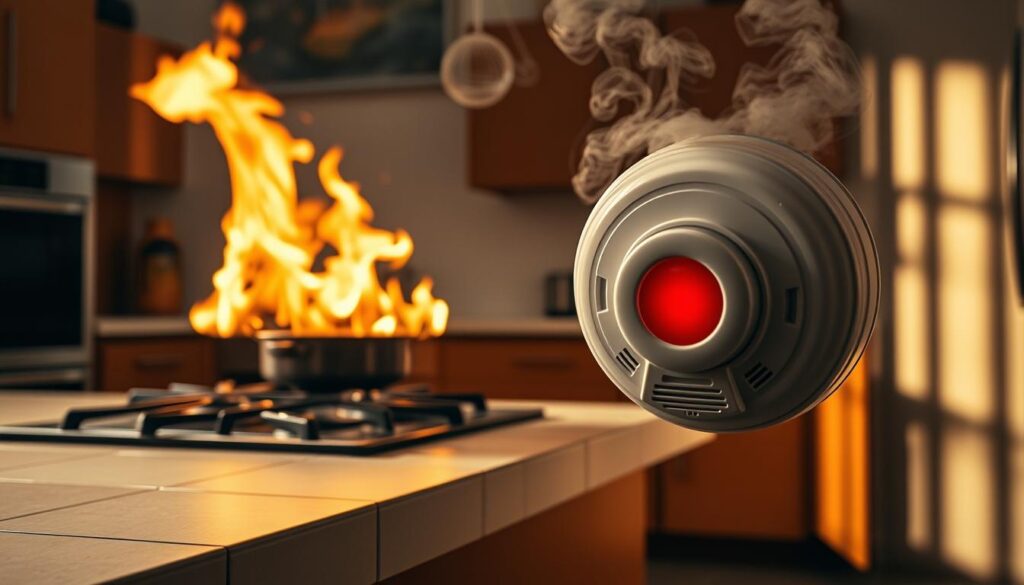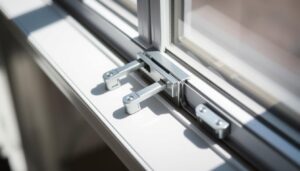Are you aware of the risks associated with cooking appliances and heat sources in your kitchen? A properly placed alarm can provide an early warning in case of overheating or a fire outbreak, allowing you to take immediate action and protect your loved ones and property.
The kitchen is a high-risk area, and having the right fire safety measures in place is crucial. This guide will walk you through the process of selecting and installing the right alarm for your kitchen, ensuring you understand the differences between smoke alarms and heat alarms.
Key Takeaways
- Understand why kitchens require special fire safety measures.
- Learn the differences between smoke alarms and heat alarms.
- Discover the UK-specific requirements for kitchen fire safety.
- Find out how to choose the right alarm for your kitchen.
- Get step-by-step instructions for installing your chosen alarm.
Understanding Heat Detectors and Their Importance
The importance of heat detectors in kitchens cannot be overstated, as they provide a reliable means of detecting potential fires. Unlike traditional smoke alarms, heat detectors are designed to detect changes in temperature, making them ideal for kitchen environments.
What is a Heat Detector?
A heat detector is a type of fire alarm that is specifically designed to detect increases in temperature, rather than smoke particles. This makes it an ideal solution for kitchens, where cooking activities can generate significant amounts of smoke and steam, potentially triggering false alarms with traditional smoke detectors. Heat detectors are engineered to ignore normal cooking by-products and only activate during genuine fire situations.
Why Kitchens Need Heat Detectors Instead of Smoke Alarms
Kitchens are prone to generating cooking smoke, steam, and vapours that can trigger false alarms in standard smoke detectors, leading to unnecessary disruption and alarm fatigue. Heat detectors, on the other hand, are designed to withstand the high humidity and temperature fluctuations common in kitchens. By installing a heat detector in your kitchen, you can significantly reduce the likelihood of nuisance alarms while still receiving crucial early warnings of potential fires.
Some key benefits of using heat detectors in kitchens include:
- Reduced false alarms due to cooking activities
- Increased reliability in detecting genuine fire hazards
- Durability in withstanding kitchen environments
- Compliance with UK building regulations and fire safety expert recommendations
Heat Detectors vs. Smoke Alarms: Key Differences
Understanding the distinction between heat detectors and smoke alarms is crucial for effective fire safety in your home. While both devices are designed to alert you to potential fires, they operate in different ways and are suited to different environments.
Smoke alarms are ideal for areas where early detection of smouldering fires is critical, such as bedrooms and living rooms. On the other hand, heat detectors are better suited for kitchens, garages, and attics where smoke alarms might be triggered by non-fire related particles.
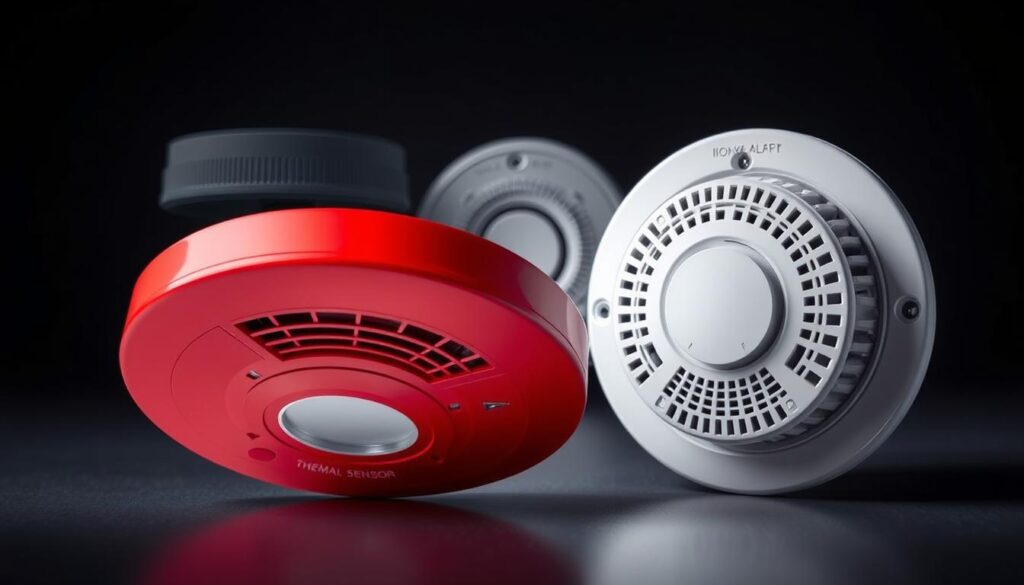
How Heat Detectors Work
Heat detectors respond to the heat generated by a fire, rather than the smoke. They are designed to trigger an alarm when the temperature in a room reaches a certain threshold, making them less prone to false alarms caused by cooking or steam.
This characteristic makes heat detectors particularly useful in the kitchen, where smoke from cooking can often trigger smoke alarms unnecessarily.
When to Use Heat Detectors vs. Smoke Alarms
The choice between heat detectors and smoke alarms depends on the specific needs of different rooms in your home. For comprehensive fire safety, it’s recommended to have both types of detectors installed in their appropriate locations.
By doing so, you can ensure that your alarm system provides maximum protection against different types of fires, enhancing overall safety.
“For optimal home protection, experts recommend creating a comprehensive system that incorporates both types of detectors in their appropriate locations throughout your property.”
UK Requirements for Kitchen Fire Safety
As a homeowner in the UK, it’s essential to be aware of the kitchen fire safety laws that apply to your property. The regulations vary across different regions, including England, Wales, and Scotland.
England and Wales Regulations
In England and Wales, the regulations regarding kitchen fire safety are less stringent compared to Scotland. However, it is still crucial to have appropriate fire safety measures in place. While there isn’t a specific requirement for heat alarms in kitchens, having a well-maintained smoke alarm system is vital.
Scotland’s Interlinked Alarm Requirements
Scotland has implemented stricter fire safety legislation. As of February 2022, homes in Scotland are required to have an interlinked smoke and heat alarm system installed. This means that when one alarm is triggered, all alarms sound simultaneously, enhancing fire safety. Specifically, an Ei3014 interlinked heat alarm must be installed in the kitchen, alongside smoke alarms in the living room, hallways, and landings.
| Region | Required Alarm Type | Installation Location |
|---|---|---|
| Scotland | Interlinked smoke and heat alarm | Kitchen (heat alarm), living room, hallways, landings (smoke alarms) |
| England and Wales | Smoke alarms | Not specified, but recommended in circulation areas |
Non-compliance with these regulations can have significant implications, including potential effects on home insurance policies and complications when selling your property.
Choosing the Right Heat Detector for Your Kitchen
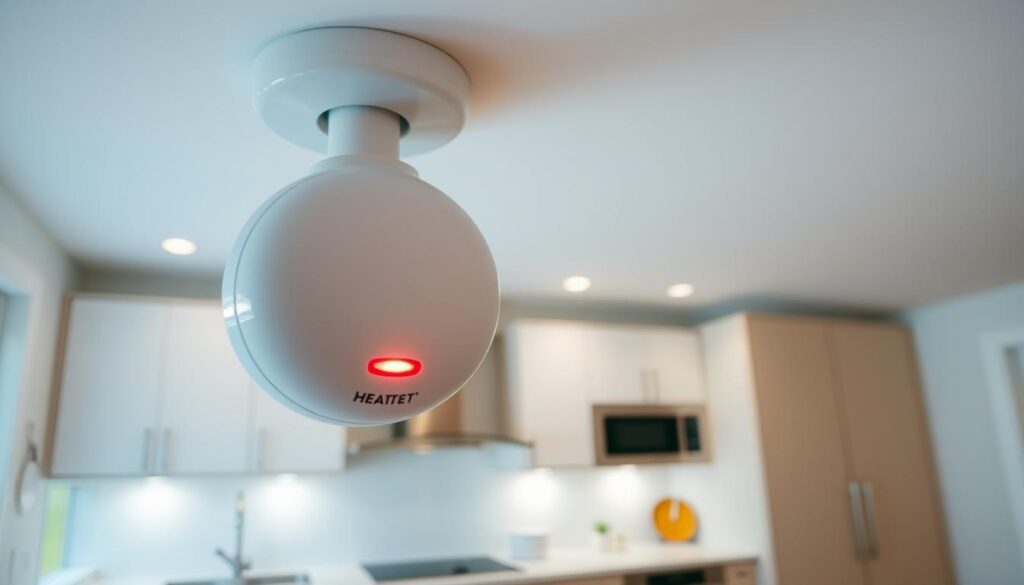
When selecting a heat detector for your kitchen, it’s essential to prioritise models that meet rigorous quality and performance standards. Ensuring your kitchen is equipped with a reliable heat alarm can significantly enhance your home’s fire safety.
Types of Heat Detectors Available
There are various types of heat detectors available, including those with sealed, long-life batteries and mains-powered options with battery backup. You should consider interconnectable heat detectors that can communicate with other alarms in your home, providing whole-house alerts regardless of where a fire originates.
Features to Look For
When choosing a heat detector, look for models with easily accessible test buttons, low-battery indicators, and hush functions to temporarily silence the alarm during non-emergency situations. It’s also crucial to select heat detectors with British Standards (BS) certification or European (CE) safety marks to ensure they are approved and safe.
Some key features to consider include:
- Heat detectors with sealed, long-life batteries (ideally 10-year) or mains-powered options with battery backup.
- Interconnectable heat detectors for whole-house alerts.
- Models with easily accessible test buttons and low-battery indicators.
- Hush functions to temporarily silence the alarm.
- Heat detectors specifically designed for kitchens with high ceilings or unusual architecture.
How to Install a Heat Detector in Kitchen: Step-by-Step Process
To ensure your kitchen is equipped with a reliable fire safety system, follow this step-by-step guide on installing a heat detector. This process is straightforward and requires some basic knowledge and tools.
Tools and Materials Needed
Before you start, make sure you have the necessary tools and materials. These typically include a drill, screws, and the heat detector unit itself. Check the manufacturer’s instructions for any specific requirements.
Determining the Optimal Location
The location of your heat detector is crucial for its effectiveness. It should be installed on the ceiling, away from any cooking appliances and vents. Ensure it is at least 300mm away from any wall or beam to prevent false alarms.
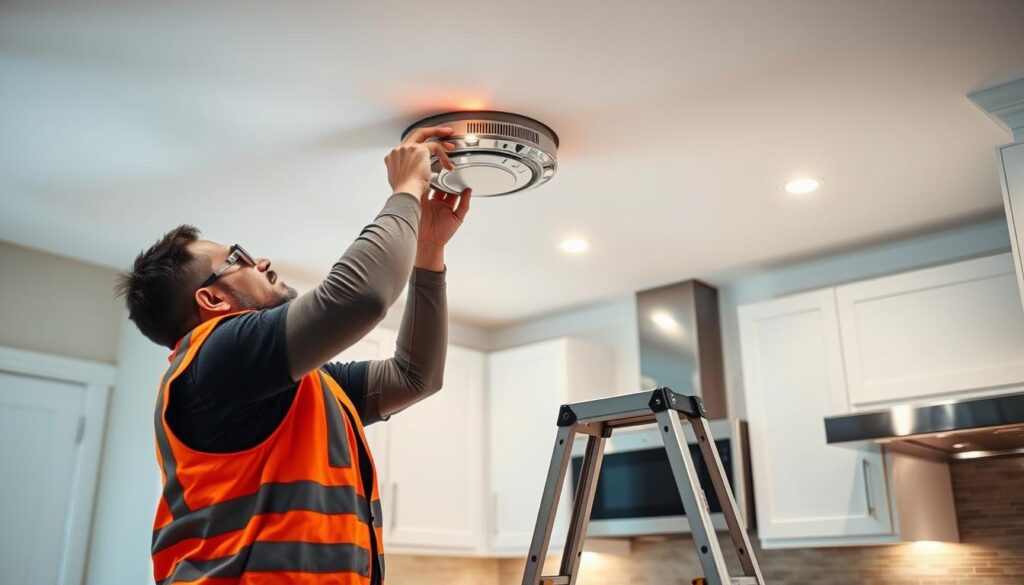
Mounting Instructions
Once you’ve determined the optimal location, you can begin mounting the heat detector. Use a drill to make holes for the screws, then secure the detector in place. Make sure it is level and firmly attached to prevent any movement.
Testing After Installation
After installation, test the heat alarm to ensure it is functioning correctly. Follow the manufacturer’s instructions for testing procedures. Typically, you can press the test button to activate the alarm and verify that the sound is loud and distinct.
- Press and hold the test button for the duration specified in the manufacturer’s instructions (typically 10 seconds).
- Listen for a loud, clear alarm sound that would be audible throughout your home.
- For interconnected systems, verify that activating the test function on your kitchen heat detector triggers all connected alarms throughout your home.
By following these steps, you can ensure your kitchen heat detector is installed correctly and working effectively to enhance your home’s fire safety.
Maintenance and Testing of Kitchen Heat Detectors
To ensure your kitchen remains a safe space, regular maintenance of your heat detector is crucial. This involves not just cleaning but also regular testing to ensure continued fire protection. A well-maintained heat detector will provide you with peace of mind, knowing that it will function correctly in case of an emergency.
Regular Testing Schedule
You should test your kitchen heat detector regularly to ensure it’s working correctly. It’s recommended to test it at least once a month. During testing, press the test button until the alarm sounds. If it doesn’t sound, check the battery or consider replacing the detector. Regular testing helps prevent false alarms and ensures your detector stays in working order.
Cleaning Your Heat Detector
Cleaning your heat detector is a simple process that helps maintain its effectiveness. Use a soft brush or a dry cloth to gently remove dust and debris from the detector’s surface. Avoid using water or cleaning products, as they can damage the device. Regular cleaning ensures your heat detector remains sensitive to heat and continues to provide reliable protection.
When to Replace Your Heat Detector
Knowing when to replace your heat detector is crucial for maintaining kitchen safety. Typically, heat detectors have a lifespan of about 10 years from the date of manufacture. Check the production date on the device and plan for replacement accordingly. If your detector fails to sound during testing, shows signs of physical damage, or produces intermittent beeping despite battery replacement, it’s time to replace it. Consider upgrading to newer models, especially during kitchen renovations, to benefit from improved technology and enhanced fire detection capabilities.
Conclusion
By installing a heat detector in your kitchen, you’re taking a crucial step towards safeguarding your home and loved ones from potential fire hazards. Unlike smoke alarms, heat detectors are designed to minimise false alarms triggered by cooking or steam, providing a more reliable warning system in the event of a fire.
Key takeaways from this guide include:
- Understanding the importance of heat detectors in kitchens and their role in preventing false alarms.
- Selecting the right heat detector for your kitchen environment based on the type and features.
- Following a step-by-step installation process to ensure optimal performance.
- Recognising that heat detectors are part of a comprehensive home fire safety strategy, complemented by smoke alarms in other areas and a family escape plan.
For more information on the differences between heat detectors and smoke alarms, you can visit this resource. By taking this simple step, you’re not only enhancing your home’s fire safety but also gaining peace of mind knowing you’ve protected your family from one of the most common household dangers.
